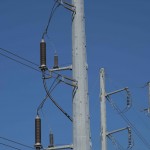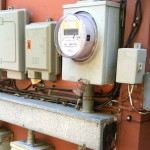Rolling Blackouts: a Black Eye For Texas?

Dave Fehling/StateImpact Texas
There’s fear in Austin over what could happen if the state runs short of electricity and has to use rolling blackouts to keep the statewide electrical grid from collapsing.
The fear is for the state’s image.
At a meeting of the Texas Public Utility Commission (PUC) June 13th, Chairman Donna Nelson expressed concern that pleas to the public to conserve electricity during the late afternoon when demand is greatest might also send a message that Texas was running out of power and therefore was no place you’d want to do business.

Courtesy PUC
PUC's Donna Nelson
“You know, we want to get the message out of reduced usage during peak demand…At the same time, we want to get the message out ‘Texas is open for business’,” Nelson said. “We want to get the message out, peak demand, turn your thermostat up a couple degrees, don’t do your laundry, those kinds of things. But we don’t want to say, ‘if you don’t we’ll have rolling outages’, OK? So, it’s a fine line to walk.”
What’s So Bad About a Blackout?
To reduce the risk of blackouts, the PUC wants to raise the cap on the price of wholesale electricity during those peak demand times in an effort to make the market more profitable. In turn, the commission hopes that’ll lure more investment to Texas to build more power plants.
But the PUC’s own consultants in a report release earlier this month cautioned that the state could go overboard trying to reduce the risk.
“You can plan on a very, very high level of reserves and almost never have to (have blackouts). That would be more expensive than maintaining a lower reserve margin. And there’s got to be a balance somewhere,” said Sam Newell, one of the authors of the report done by The Brattle Group.
The report questioned whether the standard preferred by Texas regulators, a one-outage-a-decade requiring a reserve margin just shy of 14 percent, was worth what it would cost to build new power plants.
By contrast, the report said a lower reserve margin of only 10 percent could cost far less and mean that the risk of blackouts would be only “24 outage hours” in a decade. In other words, not that big a deal in a state where customers are used to occasionally losing electricity because of wind storms and lightning.
How much money are we talking about? An industry group called Texas Industrial Energy Consumers told the PUC in a filing that the higher peak prices for wholesale electricity favored by the PUC would add from $4.5 billion to $14 billion to the total annual cost of electricity in Texas. That could translate into hundreds of dollars more a year per residential customer. The group warned commissioners that the impact of raising prices “should not be trivialized or viewed as a purely academic exercise.”
How Rolling Blackouts Work
Rolling blackouts have been rare in Texas.

Dave Fehling/StateImpact Texas
CenterPoint's Kenny Mercado
“It just doesn’t happen. I wouldn’t even say it’s once every ten years. It’s once in a long, long period of time. But we’re always prepared,” said Kenny Mercado, a VP of grid operations at CenterPoint Energy which routes electricity to 2.2 million customers in the Houston area.
Once ERCOT — the overseer of the state’s electric grid — decides to order rolling blackouts, Mercado says CenterPoint tries to minimize the pain.
“We try to reduce the duration and increase the frequency,” said Mercado.
An example of that was what Mercado said happened back in February 2011. A cold snap caused a number of ill-prepared power plants to freeze up, taking a total of some 50 plants statewide off-line. Starting early in the morning, ERCOT ordered rolling outages that lasted most of the day (the previous rolling outage in Texas was a more limited one in 2006).
“It was probably three or four (outages) for me for roughly 30 minutes spread out over an eight hour time frame,” said Mercado about what it was like at his Houston home.
For the most part, residential customers bear the burden of controlled, rolling outages. CenterPoint spares vast pockets of the Houston region: airports, downtown, the Texas Medical Center, dozens of industries primarily on the city’s east side, even the area around The Galleria shopping mall. CenterPoint provided StateImpact a map showing who lost power and who was spared in the outages of February 2011.
Different Approach in Dallas
The state’s other big electricity delivery company (as opposed to the companies that generate the power) is Oncor. Unlike CenterPoint, it says virtually every customer is fair game in a rolling outage.
“No one is exempt,” says Megan Wright with Oncor’s media relations.
In the 2011 outage, that meant that even some Dallas-area hospitals lost power.

Courtesy Methodist Dallas
Methodist Dallas Hospital was part of outage in 2011
“It caught us by surprise,” said Sandra Minatra, a spokesperson with Methodist Dallas Medical Center.
Patients were never in danger because Minatra said the hospitals own emergency generators came on instantly.
“Most any hospital is going to have a backup system but you don’t want to turn to relying on that if you don’t have to,” said Minatra.
After hospitals complained, Oncor reconsidered its policy and now has added “trauma hospitals” to a priority list that includes airports, jails and other facilities where health and safety could be jeopardized by a loss of electricity.
But Oncor’s Wright says being on the list is not an absolute guarantee of exemption from being included in an outage. She says Oncor tries to limit exclusions because “others will have to be out of electricity longer to allow others to stay on.”
The PUC commissioners are scheduled to meet Thursday morning in Austin and are expected to approve new, higher caps on the wholesale price of electricity.

